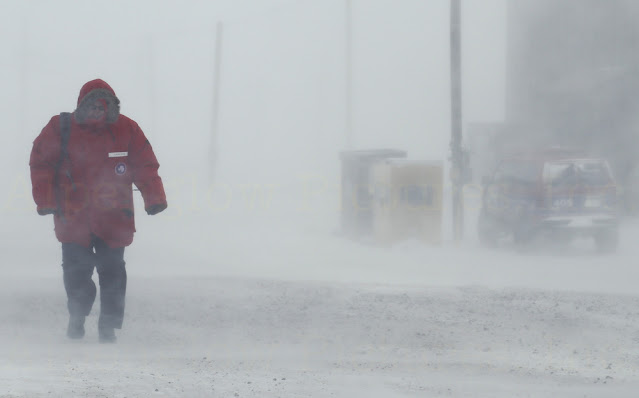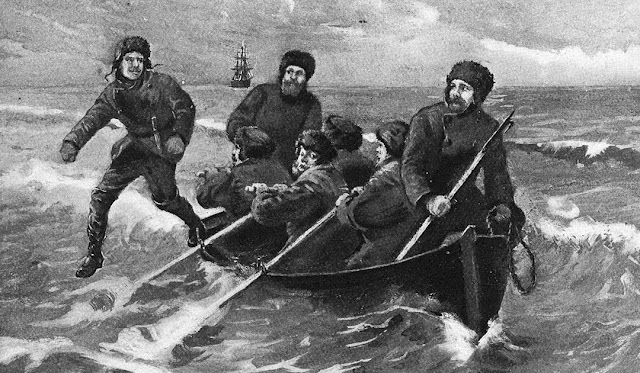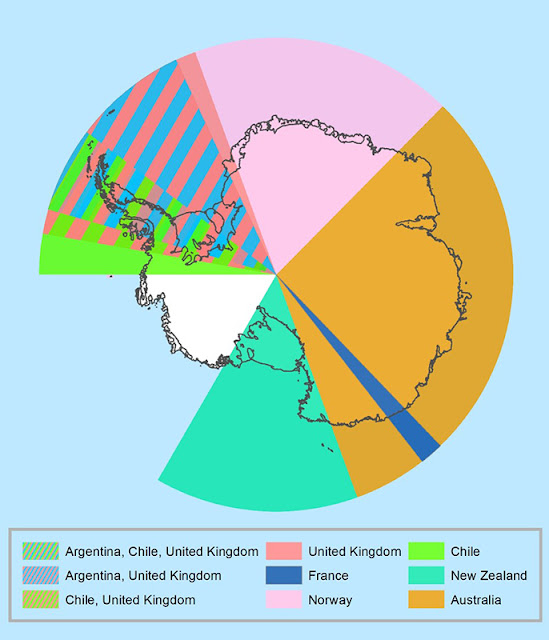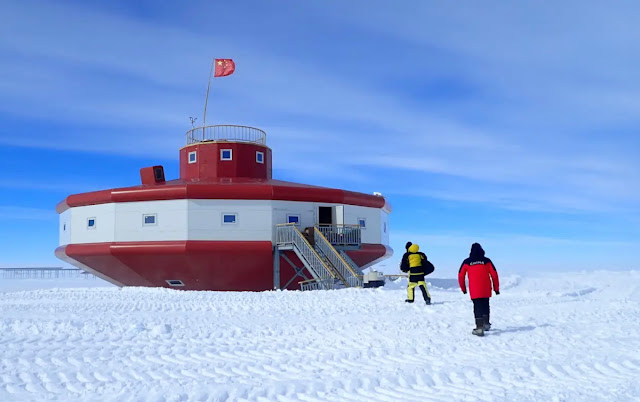
Antarctica is one of the rare places where there is no human influence. Its odd mix of animals and vegetation is incredibly striking. But if Antarctica doesn't have any human influence.
Antarctica is the only continent that isn’t a country, doesn’t have a government, nor any indigenous tribal living there for ages. One of the most obvious reasons is that it is the coldest continent in the world. The temperature can go as low as -89 C, additionally, it is also the windiest place on earth, with snowstorms at a speed of 300 Km/hr/. You might be astonished to learn that Antarctica is considered a desert because it is also the driest continent on Earth.

Snow Storm
Only 51MM of rain has fallen here so far, and even when it does, it turns into snow before it reaches the ground. So in a way, Antarctica is the only place on Earth with little to no influence of humans. However, this does not imply that numerous countries have not made an effort to conquer Antarctica.
| Country | Claimed Territory |
| Argentina | 960,000 square kilometers (370,000 sq mi) |
| Australia | 589,000 square kilometers (227,000 sq mi) |
| Chile | 1,250,000 square kilometers (483,000 sq mi) |
| France | 432,000 square kilometers (167,000 sq mi) |
| Japan | 387,000 square kilometers (150,000 sq mi) |
| New Zealand | 412,500 square kilometers (163,000 sq mi) |
| Norway | 2,800,000 square kilometers (1,100,000 sq mi) |
| Russia | 1,400,000 square kilometers (540,000 sq mi) |
| South Africa | 260,000 square kilometers (100,000 sq mi) |
| United Kingdom | 160,000 square kilometers (62,000 sq mi) |
| United States | 1,500,000 square kilometers (580,000 sq mi) |

This portion of blue line Antarctica is claimed by France, this portion in green line claimed by Norway, and the full portion on the right side is claimed by Australia. Britain, Chile, Argentina, and New Zealand claim various parts of Antarctica.
Who invented the name Antarctica?
One of the first to assert that the globe was spherical was the Greek philosopher Aristotle, who lived in 350 BC. At the time, Greeks were aware of the arctic regions in the North. They had named it the Arctocs. The word arctos was derived from the bear. The constellation that we can see in the sky, one of is of the great bear, They were inspired by that constellation and named the Arctic region, Arctos. Because they knew that the earth was spherical, they knew that the north and south were like mirror images and would have similar features. they gave the uncharted southern region the name Antarctos.
It means antithetical to the bear, the opposite of Arctos, and from here, the name Antarctic was derived. Humans stepped on Antarctica for the first time during the 1890s, but hundreds of years before that, Antarctica had started appearing on maps. When various explorers embarked on their global explorations, they were aware that if they traveled to the southern hemisphere, they would eventually come upon some land. However, they were unsure about the exact nature of the land's features or its size. For this reason, Antarctica was included on the global map that the French explorers created in 1530.

The north hemisphere is depicted on the left side, and the southern hemisphere on the right side. The largest land mass in the middle of the southern hemisphere was named Terra Australis Incognitait meant unknown southern land.

James Cook
About 200 years later, in 1773, British Naval officer James Cook became the first person to go south of the Antarctic Circle. He was about 130 Km farther from Antarctica when he turned his ship around. Even though he hadn’t seen Antarctica, he had seen icebergs with rock deposits on them. He came to the conclusion that Terra Australis exists after seeing those rocks. But going much closer to Antarctica was so dangerous, that he had famously said, “I can be bold enough to say no man will ever venture farther than have completed and that the regions to the south will never be discovered." He was so sure that no one could reach Antarctica because the place was so perilous, with strong winds blowing and the ships in danger of hitting icebergs at any moment.

First-person landed in Antarctica
But fifty years later, his words were shown to be false. The question of who set foot in Antarctica first is a hotly contested one. since many people assert that they were the original. British-American captain John Davis believed that he was the first person to do so because his ship was lost and he reached Antarctica. The first undisputed landing was in 1895, when a Norwegian ship called the Antarctic, reached its shores 6, 7 members of the Crew of this ship went into a small boat and went on the land.
A Norwegian in the boat Carsten Borchgrewink, claimed, that he landed before the boat and he was the first to step on Antarctica. However, Alexander, a man from New Zealand, claims to have been on this boat and was the first to exit it in order to keep it stable.
These two people from the same boat got into one argument about who was the first to get off and the first to step on Antarctica after this, The 20 years of the 1900s are referred to as Antarctica's "heroic years." Because there were so many trips, new scientific findings were made, and we learned a lot of new things about Antarctica. It was the first time found out that there are plants growing on this continent.

Moses Found in Antarctica
Several countries tried to lay claim to Antarctica
When several countries tried to lay claim on Antarctica, in 1908 and 1942, 7 countries claimed sovereignty over this continent these countries as Argentina, Australia, Chile, France, New Zealand, Norway, and the United Kingdom apart from them, there were countries the USA, the Soviet Union, Japan, Sweden, Belgium, and Germany who were conducting exploration conducting New expedition on Antarctica, without claiming any territory.
State America announced its official position regarding the territorial claims on Antarctica
During Hitler's rule, in 1939, A German Antarctic expedition wascarried out in which they flew in an airplane to take pictures of some areas ofAntarctica. They even dropped metal nazi swastikas, claiming that the area where the swastikas were dropped, was under the control of Nazi Germany. Surprisingly, during this period, the USA wasn't very active.
In 1924, the Secretary of State America announced their official position regarding the territorial claims on Antarctica. He said that if any country discovers new Land in Antarctica, it doesn't mean that the new area, would belong to the country. The land belongs to the country only when there is actually settlement in the area. When the citizens of that country live there permanently.
Research centres in Antarctica
These nations began battling one another following the end of World War II over their respective claims to Antarctica's territory. It means that they were expressing their claims more strongly. These countries set up permanent research centres in Antarctica. To show that they have a permanent station in the area, and since researchers were living there permanently, they claimed the land as theirs. There are several Islands near Antarctica. The heard and Macquarie island, on which Australia established stations in 1947-48. On the islands of Kerguelen and Crozet, France established bases in 1953.

Geopolitics
The next year, in 1954, Australia reached mainland Antarctica and set up the Mawson station. It was on Antarctica's continent. One year later, Argentina set up the General Belgrano station, which was in Antarctica on the Filchner -Ronne Ice Shelf. There's so much ice in Antarctica, that it makes it difficult to know if there is land under all that ice.
Setting up research stations had become a political strategy of the countries. The British, Chilean, and Argentinian bases were at one point so near to one another that it was obvious they weren't built just for scientific investigation.

The fact that these stations were being set up for intelligence operations was immediately apparent. In fact, the territorial claims of these countries on Antarctica overlap.
Soviet Union government
The Soviet Union's government warned the rest of the world in a memo it sent out in 1950 that it would not recognize any claims to Antarctica's territory made by a nation without its consent or by one that participated in decisions regarding the continent. But this time, a cold war broke out between America and Russia, and people were afraid that the two countries start their geopolitics in Antarctica as well.
Treaty of Antarctica
These countries were already fighting each other in multiple areas of the world, but no one wanted them to be fighting in Antarctica too, but it didn't happen. In 1958, American president Eisenhower, issued notice to the rest of the government, "calling for a treaty to ensure that Antarctica would always be a free and peaceful place. In Washington on 15th October 1959, the conference was held on it, and on 1 December 1959, the Antarctic treaty was signed.
There were major points in this treaty.
- Antarctica would be used for peaceful purposes only.
- Everyone would be free to carry out scientific
- The results of the scientific observation would be freely exchanged and available to all.
Twelve governments, including all of those with claims to Antarctica, first ratified this convention. However, the most intriguing aspect of this pact is that the claims of these nations were not eliminated. This treaty merely suspended those claims temporarily. Legally these countries to claim those territories and they are doing so indeed.
Political map of Antarctica
This political map of Antarctica is still valid. Australia claims the largest share, Australia claims 42% of Antarctica. But it is also important to notice that America rejects the claims of these countries, not only America, but most of the world countries around the world, reject these territorial claims.

In addition, none of the seven nations who are vying for control of Antarctica recognize & the claims of the others. France, Australia, Norway, and New Zealand recognize each other's claims, but UK Chile, and Argentina do not recognize each other claims because their territories overlap.
International Council of Scientific Unions
The International Council of Scientific Unions established a special committee to conduct research on Antarctica. Under which scientists from different countries coordinate together. Due to the significant collaboration between scientists from various nations, approximately 4500 scientists travel to Antarctica each year to conduct research.
Madrid Protocol
Later, in 1991, an environmental protection pact known as the Madrid Protocol was named because it was signed in Madrid, the Spanish capital was signed in Antarctica. Finally, this convention imposed limitations on drilling and mining operations in Antarctica; no nation is permitted to conduct these activities there.
Exploration of oil Antarctica
It was crucial to take this action because many nations are oil scavengers. A lot of locations have been destroyed under the pretense of "oil exploration." Experts from the US Geological Survey discovered that 19 billion barrels of oil can be extracted from beneath Antarctica in a research dated 1992. There are 500 billion barrels of oil and gas, according to Russian mineral explorers, under Antarctica. However, there are two reasons why oil mining hasn't yet been done in Antarctica. The Madrid Protocol is the first reason treaty that keeps us protected from such instances, it will be quite expensive to do so.

But in the future, due to climate change, the threat increase further. Climate warming is causing this ice to melt, making it simpler to reach Antarctica. New technologies will be developed with time, and perhaps then it won’t be an expensive affair. And it becoming economically viable to extract oil and gas from there.

After the year 2000, China is the only country that has set up research stations in Antarctica. Apart from this according to the data from 2018, there were several private yachts, carrying wealthy private individuals who went to mainland Antarctica, and illegally exploited nature there. Many nations agree that a new convention should be established to manage the ocean area surrounding Antarctica to prevent & overfishing.
Conclusion:
The nations that currently have land claims in Antarctica only have a symbolic claim. Although the claims had been temporarily put on hold by this treaty, it also meant that these territorial claims would become significant after the pact expired. This is why these 7 countries have held into their claims over Antarctica. The deadline for this treaty is 2048.
After 2003, there was a permanent physical presence of the Antarctica treaty as well. The headquarters is in Buenos Aries, Argentina.





0 Comments